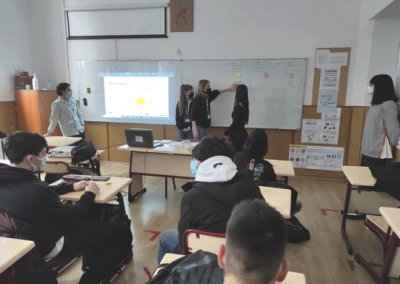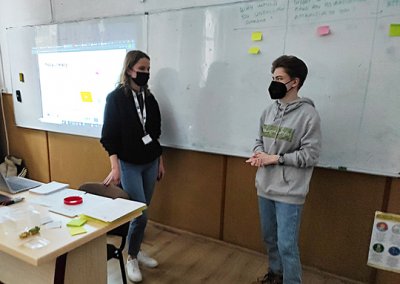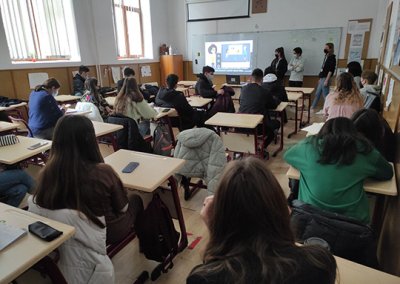Media and Information Literacy
Another week, another great workshop with Constanţa youth! On Monday, 7th of February, we met a new 10th grade class in the Mihai Eminescu high school. We exchange with class F and its 32 students. It lasted for 40 minutes.
The theme of our workshop was the same last week. It was Media & information literacy, which is the ability to analyse, evaluate, and create media in a variety of forms. Essentially, our goal was to explain this concept. We also wanted to explain to the students that every media content has an objective and a message, even if it is not clear sometimes.
Breaking the ice
At first, we started by presenting ourselves and the T4E organisation. Then, we began a short game with the students to make them share their experience on this subject. Doina explained the rules. Each student had one candy. Depending on its color (red, yellow or green) they had to answer one question:
- Yellow: Why would you unfollow someone on social media?
- Red: What would make an advertisement attractive to you?
- Green: What would make an advertisement unattractive to you?
Basically, every student had to write their answer on a sticky note. A few of them came to the board to stick it on the flipchart in the corresponding column. They also explained their answers.
Deconstructing advertisements
Then, Théo, our new volunteer from Nantes (France), detailed what media literacy is. First, he showed participants a YouTube video about it to the class. After that, he gave some examples of the various forms of media content. It can be songs, movies, TV shows, radio and TV reports, newspapers articles, video games, photos or advertisements.
In addition, we showed a screenshot from a soda commercial to the class. On one hand, we asked them to analyse it and, on the other hand, to find the hidden message the brand wanted to convey. The goal was to understand the concept of subliminal messages. In a nutshell, this is when advertisers use visual or auditory stimuli that the conscious mind cannot perceive. It is to strengthen the persuasiveness of advertisements.
Moreover, we also taught the students to identify the 4 different strategies brands are using to sell their product of services:
- Entertain: to engage a large audience is through humour or an interesting story
- Persuade: using rhetoric to make you agree with the product/service
- Inspire: making the customer think they can become someone else with the product
- Educate: to teach a customer about the product/service and explain why it can be useful
Applying what they have learned
Firstly, the class F students were given 4 examples of advertisements. They had to identify which strategy each ad used. In fact, they discover that it was not that easy to deconstruct!
Secondly, Doina asked them to apply this knowledge on an advertising poster from a coffee shop company. Among the questions:
- What is the message behind it?
- Who created it or who paid for it?
- Who is the “target audience” and what is the implicit message?
Some students gave their opinion about it. They were diverse. This showed that everyone can understand those messages differently.
Finally, we gave them feedback sheets to know their understanding of the workshop. Most of them were pleased but some asked us to be more interactive and to better divide our speeches among us volunteers. We are happy to apply those recommendations for our next workshop!
Location: Mihai Eminescu high school, Constanta, Romania
Date: 7th of February, 2022
Want to see more about our Erasmus events?
Build confidence | Recognize own abilities | Broaden horizons




